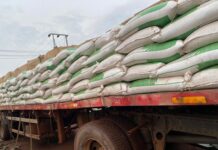Maize, beans and cassava production has increased over the past three years.
IN SUMMERY
• A report released this past week notes that production and export volumes of the three food crops has increased over the past three years.
• The report says government prioritised maize production “due to its high potential for food security and contribution to export earnings.”
• In the financial year 2015/16, Uganda’s maize production stood at 2.26 tonnes, with the country exporting 308,911 tonnes worth $102.2 million.
Production of food particularly maize, beans and cassava has increased over the past three financial years in Uganda, even as the region lives in fear of looming food insecurity due to unreliable rains and adverse weather.
A report released by the country’s Ministry of Agriculture this past week notes that production and export volumes of the three food crops has increased over the past three financial years.
The report says government prioritised maize production “due to its high potential for food security and contribution to export earnings.”
In the financial year 2015/16, Uganda’s maize production stood at 2.26 tonnes, with the country exporting 308,911 tonnes worth $102.2 million.
In 2017/2018, production increased to 3.2 million tonnes and the country exported 1.36 tonnes of maize worth $352.1 million
Government programmes like the Operation Wealth Creation saw over 14.6 million bags of maize seeds distributed to both commercial and small scale farmers in 104 districts since 2016.
The volume of beans—which are grown mainly by household farmers—was 1.1 million tonnes in the financial year 2016/2017, with exports at 144,925 tonnes worth $71.8 million.
The following financial year, according to the report presented by Agriculture Minister Vincent Ssempijja, the volume of beans increased to 1.21 million tonnes.
Cassava which is also used to make flour, animal feeds and alcohol, saw an increase from 3.02 million tonnes in 2015/16 to 3.4 million tonnes in 2017 /2018 but authorities say the crop has potential to do better.
“The ministry has developed programmes to promote research in high yielding and climate resilient varieties which are now being disseminated in the area with the best production capacity,” the report notes
Other food crops whose production volumes increased are rice and fruits.
Food insecurity
The increase in production comes at a time regional governments are predicting food insecurity and possible famine after intense droughts, rainstorms and flooding in parts of Kenya and Uganda.
Because of increased drought and unpredictable rainfall, the Office of the Prime Minister projects that harvests from the country’s first farming season this year will fall by 50 per cent compared with the first crop season of 2018.
The country has also reportedly budgeted for Ush40 million ($10.5 million) for emergency procurement of food items and Ush39 billion ($10.2 million) for fast maturing seed varieties of food crops like maize and beans.
Agriculture junior minister Christopher Kibazanga said that the ministry has submitted a request for a supplementary budget to purchase fast growing seeds to fill the predicted food gaps this year
In recent years, Uganda has experienced food shortages in areas like Karamoja, Teso and Nakasongola which lie within the cattle corridor, but the country enjoys food availability in the central and western regions throughout the year.
The discrepancies, Mr Kibazanga said, are due to a lack of interest from the private sector and the absence of market linkages both locally and internationally.
“Farmers and vendors in parts of the country experience food rotting while there is no food in other parts,” he said.
“There is a need for the private sector to exploit the distribution chain and identify regions where food is in plenty and take it to where it is needed most.”
To mitigate the ripple effects of climate change which threatens the region’s food security, government is supporting agriculture modernisation and research, as well as better agronomical practices like the use of improved technologies, provision of extension services, control of pests, vectors and diseases, mechanisation, and investment in irrigation.








